Telangana TSBIE TS Inter 2nd Year Botany Study Material 4th Lesson Photosynthesis in Higher Plants Textbook Questions and Answers.
TS Inter 2nd Year Botany Study Material 4th Lesson Photosynthesis in Higher Plants
Very Short Answer Type Questions
Question 1.
Name the processes which take place in the grana and stroma regions of chloroplasts.
Answer:
1. Grana :
Light reactions – trapping the light energy by membrane systems and synthesis of ATP and NADPH.
2. Stroma :
Dark reactions – carbon fixation leading to synthesis of sugars.
Question 2.
Can chloroplasts be passed on to progeny? How?
Answer:
- Yes, nearly equal number of chloroplasts among 2 daughter cells formed from a mother cell during mitosis.
- Maternal inheritance (cytoplasm of egg) in a sexually reproducing plant.
Question 3.
Where does the photolysis of H2O occur? What is its significance? [Mar. ’20, 17; May ’14]
Answer:
- Membrane of grana thylakoid and is associated with PSII.
- Oxygen liberated by splitting of H2Ois the main source of atmospheric O2, electrons released during photolysis replace those removed for PSI.
Question 4.
Where is the enzyme NADP reductase located? What is released if the proton gradient breaksdown?
Answer:
- The enzyme NADP reductase is located on the stroma side of the grana thylakoid membrane.
- Energy is released if the proton gradient breaks down and is stored in ATP.
Question 5.
Which tissue transports photosynthates ? What experiments prove this?
Answer:
- Phloem
- Ringing experiment
![]()
Question 6.
How many molecules of ATP and NADPH are needed to fix a molecule of CO2 in C3 plants? Where does this process occur?
Answer:
- In C3 plants, 3 molecules of ATP and 2 molecules of NADPH are required to fix one CO2 molecule.
- This process occurs by Calvin cycle in the stroma of chloroplast.
Question 7.
Explain the terms:
a) Hatch-Slack pathway
b) Calvin cycle
c) PEP carboxylase
d) Bundle sheath cells
Answer:
a) Hatch-Slack pathway :
It is also called as C4 cycle because the first stable compound in this cycle is a four carbon compound OAA (Oxalo Acetic Acid).
b) Calvin cycle :
It is also called as C3 pathway, because the first stable compound is this cycle is a three carbon compound PGA (phosphoglyceric acid)
c) PEP carboxylase :
The enzyme responsible for primary fixation of CO2 in C4 plants. It mediates the formation of C4 acids by reaction of CO2 with phosphoenolpyruvate.
d) Bundle sheath cells :
The large cells with thick walls impervious to gaseous exchange and no intercelliilo spaces present around the vascular bundles of the C4 pathway plants. These cells are characterised by a large number of agranular chloroplasts.
Question 8.
What is the role of NADP reductase in the development of proton gradient?
Answer:
- The NADP reductase enzyme is located on the stroma side of the membrane.
- It mediates the reduction of NADP+ to NADH + H+, creates protos gradient across the granathylakoid membrane.
Question 9.
Mention the components of ATPase enzyme. What is their location? Which part of the enzyme shows conformational change?
Answer:
- The ATPase enzyme consists of two parts : a) F0 (stalk) is embedded in thylakoid membrane and b) F1 (head) that protrudes into the stroma.
- F1 particle of the ATPase undergoes conformational changes to synthesize ATP molecules.
Question 10.
What products drive Calvin Cycle? What process regenerates them?
Answer:
- ATP and NADPH
- Light reaction – phostophosphorylation.
Question 11.
What is the basis for designating. C3 and C4 pathway of photosynthesis?
Answer:
1. C3 Pathway :
In plants with this pathway, the first product of CO2 fixation is a 3 Carbon containing acid (3 – phosphoglyceric acid / 3 – PGA).
2. C4 Pathway :
In plants with this pathway, the first product of CO2 fixation is a 4 Carbon containing acid (oxaloacetic acid / OAA).
Question 12.
Distinguish between action spectrum and absorption spectrum.
Answer:
- Action spectrum is the graph showing rate of photosynthesis as a function of different wavelengths of light.
- Absorption spectrum is the graph shows the absorption of different wavelengths of light by photosynthetic pigments.
![]()
Question 13.
Of the basic raw materials of photosynthesis, what is reduced? What is oxidised?
Answer:
- CO2 and H2O are the two raw materials of photosynthesis.
- CO2 is reduced and H2O is oxidized during photosynthesis.
Question 14.
Define the law of limiting factors proposed by Blackman. [Mar. 2019, May 2017]
Answer:
If a process (like photosynthesis) is conditioned as to its rapidity by a number of separate factors, the rate of the process is limited by the factor that is present in a relative minimal value.
Question 15.
What is Joseph Priestley’s contribution to the study of photosynthesis?
Answer:
- Plants restore to the air whatever breathing animals and burning candles remove, i.e., O2 is evolved during photosynthesis.
- His experiments revealed the essential role of air in the growth of green plants.
Question 16.
Comment on the contribution of Van Niel to the understanding of photosynthesis.
Answer:
- Experiments by Van Niel, on purple and green bacteria demonstrated that photosynthesis is essentially a light – dependent reaction.
- Niel inferred that the O2 evolved by the green plant comes from H2O, not from CO2.

Question 17.
With reference to photosystem, bring out the meaning of the terms a) antennae b) reaction centre.
Answer:
a) Antennae :
All the pigments of a photosynten that form a light harvesting system. Those pigments absorb different wavelengths of light,
b) Reaction centre :
A special chlorophyll a in a photosystem forms. It converts light energy into chemical energy. In PS I, the reaction centre is P700 that has an absorption peak at 700 nm. In PS II, the reaction centre is P680 that has an absorption maximum at 680nm.
Question 18.
Why is photosynthetic electron transport from H2O to NADP+, named as Z-scheme?
Answer:
- The electrons released by photolysis are transported to NADP+ via PS II, electron carriers, PS I and electron carriers in non cyclic manner.
- In this, when all the carriers are placed in a sequence on a redox potential scale it appears like ‘Z’ and hence called as z – scheme.
Question 19.
What is the primary acceptor of CO2 in C3 plants? What is the first stable compound formed in a Calvin cycle?
Answer:
- The primary acceptor of CO2 in C3 plants is RuBP (Rubilose bi phosphate).
- The first stable compound formed in a Calvin cycle is PGA (phosphoglyceric acid).
![]()
Question 20.
What is the primary acceptor of CO2 in C4 plants? What is the first compound formed as a result of primary carboxylation in the C4 pathway? [Mar. 2018]
Answer:
- The primary acceptor of CO2 in C4 plants is PEP (phosphoenol pyruvate).
- The first compound formed due to primary carboxylation in the C4 pathway is OAA (oxaloacetic acid).
Short Answer Type Questions
Question 1.
Succulents are known to keep their stomata closed during the day to check transpiration. How do they meet their photosynthetic CO2 requirements?
Answer:
- Succulent plants have only one kind of photosynthetic cell in which CO2 is fixed during night and used to make glucose during day.
- In succulent plants there is an alternative pathway of CO2 fixatibn called Crassulacean Acid Metabolism (CAM). E.g.: Cacti Crassulaceae is one family of succulent plants.
- CAM pathway is similar to C4 pathway in that CO2 is trapped by highly efficient PEP carboxylase during night time.
- During day time, the malic acid undergoes oxidative carboxylation to form Pyruvic acid & CO2. CO2 is used for photosynthesis.
Question 2.
Chlorophyll ‘a’ is the primary pigment for light reaction. What are accessory pigments? What is their role in photosynthesis?
Answer:
- Chlorophyll ‘a’ is the primary pigment for light reaction other thylakoid pigments like chlorophyll b, xanthophylls and carotenoids are accessory pigments.
- Accessory pigments also absorb light and transferthe energy to chlorophyll a.
- They utilise wider range of wavelength of incoming light for photosynthesis.
- They also protect chlorophyll a from photo oxidation.
Question 3.
Does ‘dark reaction’ of photosynthesis require light? Explain.
Answer:
- No. Dark reaction does not depend on the presence of light but is dependent on the products of the light reaction i.e., ATP and NADPH besides H2O and CO2.
- ATP and NADPH are used to drive the process leading to the synthesis of food, sugars. This is called biosynthetic phase of photosynthesis.
- By convention, it is called dark reaction. However this should not be taken to mean that they occur in darkness.
- This could be verified. It is simple. Immediately after light becomes unavailable, the biosynthetic process continues for sometime and then stops. If then, light is made available, the synthesis starts again.
Question 4.
How are photosynthesis and respiration related to each other?
Answer:
- Photosynthesis is an anabolic process. Simple substances like carbondioxide and water combine and yield complex carbohydrates. E.g.: Glucose
Respiration is an catabolic process. Complex carbohydrates (food materials) are broken into simpler substances like CO2 and H2O. - Photosynthesis is a reductive process where as respiration is a oxidative process.
- Photosynthesis is an endogonic process where as respiration is endergonic process.
- In photosynthesis O2 is a by product. In Respiration O2 is utilised.
- Thus photosynthesis is opposite to respiration Photosynthesis equation is

Respiration equation is
C6H120, + 6O2 → 6CO2 + 6H2O + 686 k.Cal
![]()
Question 5.
What conditions enable “RuBisCO” to function as oxygenase? Explain the ensuing process.
Answer:
RuBisCO is characterised by the fact that its active site can bind tb both CO2 and O2. It is the relative concentration of O2 and CO2 that determines which of the two will bind to the enzyme. If O2 concentration is more, RuBisCO function as Oxygenase, it binds with O2 and instead of forming 2 molecules of PGA, it forms one molecule of phosphoglycerate and phosphoglycolate. This pathway is called photorespiration.
In photorespiration pathway, sugars or ATP are not formed, moreover, there is a release of CO2 with the utilisation of ATP. Therefore photorespiration is a wasteful process.
Question 6.
Why does the rate of photosynthesis decrease at higher temperatures?
Answer:
- The effect of temperature is linked with the optimum range of enzymatic activity.
- The dark reactions, being enzymatic, they are temperature controlled. Though the light reactions are also temperature sensitive they are affected to a much lesser extent.
- Tropical plants (C4 plants) respond to higher temperatures than temperate plants (C3 plants).
- As enzymes gets denatured at higher temperatures the rate of photosynthesis decreases.
Question 7.
Explain how, during light reaction of photosynthesis, ATP synthesis is a chemiosmotic phenomenon.
Answer:
- ATP synthesis in the chloroplast is a chemiosmotic phenomenon.
- Like in respiration, in photosynthesis also ATP synthesis is linked to development of a proton gradient across the membrane.
- During splitting of water and also during oxidation of PQ. (plastoquinol) protons are released into the lumen of thylakoid.
- Hence the concentration of protons is many times greater than that of stroma, thus leading to proton concentration gradient.
Because of the concentration difference the protons try to move into the stroma, but thylakoids are impermeable to protons (H+).
However an enzyme complex ATPase enzyme is present in the membrane. It allows th’e movement of H+ through it into the stroma.
The ATPase enzyme consists of two parts.
- F0 is embeded in the membrane and forms a transmembrane channel that carries out facilitated diffusion of protons across the membrane.
- F1 that comes out of the stroma.
- The breakdown of the gradient provides enough energy to cause a conformational change in the F1 particle of the ATPase, which makes the enzyme synthesis several molecules of energy – packed ATP.
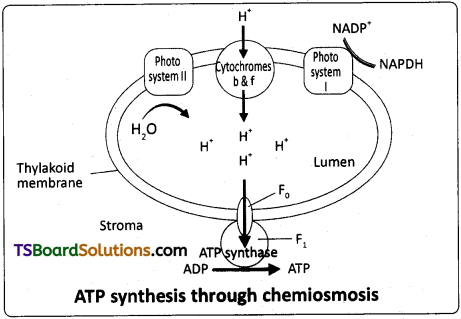
Question 8.
Explain how Calvin worked out the complete biosynthetic pathway for the synthesis of sugar.
Answer:
- The process leading to the synthesis of sugars is called biosynthetic phase of photosynthesis.
- ATP and NADPH are used in biosynthetic phase CO2 combines with H2O toTorm (CH2O) or sugar.
- The use of radioactive 14C by him in algal photosynthesis led to the discovery that the first CO2 fixation product was a 3 – carbon organic acid.
- Calvin also contributed to working out the complete biosynthetic pathway. Hence it is called Calvin cycle.
- Calvin cycle occurs in all photosynthetic plants.
- Calvin cycle can be described in three stages.
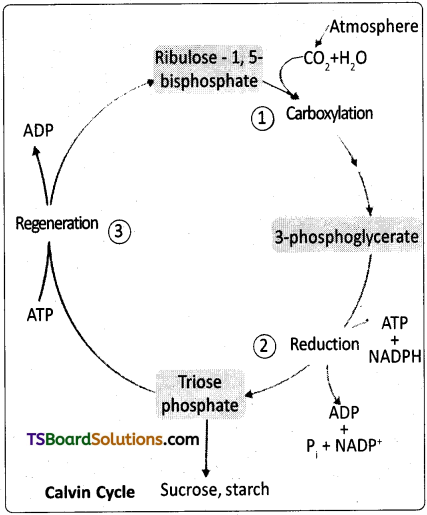
a) Carboxylation :
During which CO2 combines with ribulose 1, 5 bisphosphate and form 3 phosphoglyceric acid.
b) Reduction :
During which carbohydrate is formed at the expense of the photochemically made ATP and NADPH.
c) Regeneration :
During which the CO2 acceptor ribulose-1, 5 bisphosphate is formed again so that the cycle continues.
Question 9.
Six turns of Calvin cycle are required to generate one molecule of glucose. Explain.
Answer:
- With each turn of Calvin cycle, one CO2 molecule enters the system.
- With three turns, uptake of 3 molecules of CO2 and one triose (G – 3P) is available.
- Hence six turns, results in the uptake of six molecules of CO2 accounts for two triose (G – 3P), ultimately forms a glucose molecule.
- Thus the fixation of six molecules of CO2 and 6 turns of the cycle are required for the removal (net gain) of two molecules of triose (= one glucose molecule) from the pathway.
- For every CO2 molecule entering the Calvin cycle 3 molecules of ATP and 2 of NADPH are required. To make one molecule of glucose 6 turns of the cycle are required. Then for 6CO2, 18 ATP and 12 NADPH are required.
![]()
Question 10.
With the help of diagram, explain briefly the process of cyclic photo – phosphorylation. [May 2014]
Answer:
- In cyclic photo phosphorylation only PS I is functional, the electron is circulated within the photosystem and the phosphorylation occurs due to the cyclic flow of electrons.
- This takes place in stroma lamellae.
- Electrons in the reaction centre of PS I gets excited when they receive red light of wavelength 700 nm.
- In this process, the electrons from the reaction centre of P700 are conveyed to e- acceptor.
- The excited electron is cycled back to PS I complex through electron transport system.
- The cyclic flow results in the synthesis of ATP.
- Cyclic photo phosphorylation also occurs when only light of wavelength beyond 680 nm is available.
- In green plants, cyclic photo phosphorylation is an additional source of ATP required for chloroplast activities over and above that is required in the Calvin cycle.
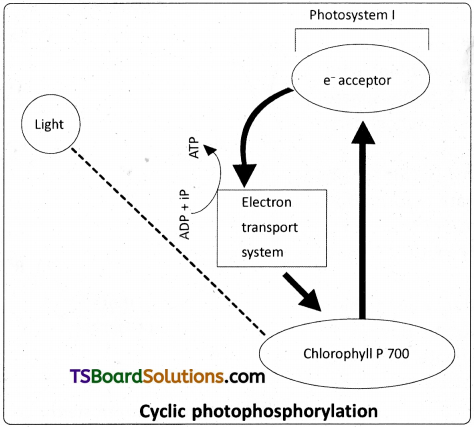
Question 11.
In what type of plants do you come across ‘Kranz’ anatomy? To which conditions are those plants better adapted? How are these plants better adapted than the plants, which lack this anatomy?
Answer:
a) C4 plants.
b) C4 plants are better adapted to dry tropical regions, they tolerate high temperatures.
c) C4 plants are special. They have a special type of leaf anatomy.
They tolerate higher temperatures.
They show a response to high light intensities.
They lack a process called photorespiration.
They have greater productivity of biomass.
Question 12.
Explain the structure of the chloroplast. Draw a neat labelled diagram.
Answer:
Chloroplasts are double membrane bound. The space limited by the inner membrane of the chloroplast is called stroma. In the stroma, flattened membrane sacs called Thylakoids are present. Thylakoids are arranged in stacks like a piles of coins called grana. In addition there are flat membranous tubules called the stroma lamellae connecting the thylakoids of the different grana. The space in the thylakoids is called lumen. The stroma contains enzymes for the synthesis of carbohydrates and protein Dark reaction takes place in stroma. It also contain circular DNA and ribosomes. Thylakoids contain photosynthetic pigment. In it light reaction occurs.
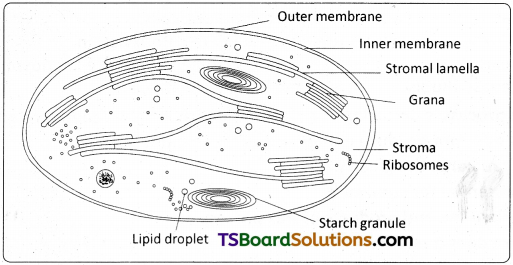
Diagrammatic representation of an electron micrograph of a section of chloroplast
Question 13.
Explain why 12 molecules of water are used as substrate, instead of 6 molecules of water, in the following equation.
![]()
Answer:
By the middle of nineteenth century the key features of plant photosynthesis were know, namely, that plants could use light energy to make carbohydrates from CO2 and water.
![]()
In the equation when 6 molecules of water is used it denotes that O2 is evolved from CO2.
![]()
But Cornelius Van Neil of based on his studies (1897 -1985) purple and green bacteria demonstrated that photosynthesis is – light essentially a dependent reaction in which hydrogen from a suitable oxidisable compound reduces CO2 to carbohydrates. This is expressed as
![]()
In green plants H2O is the hydrogen donor and is oxidised to O2. Some organisms do not release O2 during photosynthesis. When H2S is the hydrogen donor for purple and green sulphur bacteria, the ‘oxidation’ product is sulphur or sulphate depending on the arganism and not O2. Hence Niel inferred that the O2 evolved by the green plant comes from H2O, not from CO2. This was later proved by using isotopic techniques. The correct equation is
![]()
Question 14.
Compare and contrast the absorption spectrum of chlorophylls and carotenoids.
Answer:
Absorption spectrum is a graph showing the absorption of light by pigments at different wavelengths. Chlorophyll a shows the maximum absorption of light and also shows higher rate of photosynthesis in the blue and red regions. Hence we can conclude that chlorophyll a is the chief pigment associated with photosynthesis.
Carotenoid is an accessory pigment. It also absorbs light and transfer the energy to chlorophyll a.
Question 15.
Which group of plants exhibits two types of photosynthetic cells? What is the first product of carboxylation? What carboxylating enzyme is present in bundle sheath cells and mesophyll cells?
Answer:
- C4 plants exhibit two types of photosynthetic cells.
- OAA (oxaloacetic acid) is the first product of carboxylation.
- PEP carboxylase is present in mesophyll cells Ribulose biphosphate carboxylase- oxygenase (RuBisCO) is present in bundle sheath cells.
![]()
Question 16.
A cyclic process is occurring in a C3 plant, which is light dependent and needs O2. This process does not produce energy rather it consumes energy.
a) Can you name the given process?
b) Is it essential for survival?
c) What are the end products of this process?
d) Where does it occur?
Answer:
a) Yes, it is photorespiration.
b) Yes, though it is wasteful process, it is essential, as it protects from photo oxidative damage.
c) CO2 is the end product.
d) It occurs in chloroplast, peroxysomes and mitochondria.
Question 17.
Suppose Euphorbia and Maize are grown in the tropical area.
a) Which one of them do you think will be able to survive under such conditions?
b) Which one of them is more efficient in terms of photosynthetic activity?
c) What differences do you think are there in the leaf?
Answer:
a) Euphorbia (C4 plants grown in tropical area)
b) Maize CO2 fixation is done both in Mesophyll cell and Bundle sheath cell.
c) Kranz anatomy in Maize leaf.
Long Answer Type Questions
Question 1.
The entire process of photosynthesis consists of a number of reactions. Where in the cell do each of these take place?
a) Synthesis of ATP and NADPH
b) Photolysis of water
c) Fixation of CO2
d) Synthesis of sugar molecule
e) Synthesis of starch
Answer:
a) This occur in Grana thylakoid.
b) PS II – Oxygen Evolving Complex (OEC) is associated with the PS II, which itself is physically located on the inner side of the membrane of the thylakoid.
c) Stroma of chloroplast.
d) Cytoplasm
e) Cytoplasm
Question 2.
Which property of pigments is responsible for its ability to initiate the process of photosynthesis? Why is the rate of photosynthesis higher in red and blue regions of the spectrum of light?
Answer:
- Ability to absorb light at specific wavelength initiates the process of photosynthesis.
- Absorption spectrum of chlorophyll a show maximum absorption of light at blue and red regions.
- Action spectrum shows the rate of photosynthesis it is maximum at blue and red region.
- Absorption spectrum and action spectrum clearly indicate that chlorophyll a is the chief pigment associated with photosynthesis. The rate of photosynthesis is higher in red and blue regions of the spectrum due to it absorption of light wavelengths.
Question 3.
Under what conditions are C4 plants superior to C3?
Answer:
| C3 plants | C4 plants |
| 1. In C3 plants chloroplast dimorphism is not present. Cells participating will have only one type of chloroplast. | 1. In C4 plants chloroplasts show dimorphism. Cell participating will have two types of chloroplasts (agranal and granal). |
| 2. Only Calvin cycle occurs. | 2. C4 pathway in mesophyll cells and Calvin cycle in bundle sheath cells takes place. |
| 3. C3 plants are less efficient in utilizing the atmospheric CO2. | 3. Move efficient in utilizingthe atmospheric CO2. |
| 4. Photorespiration (a waste process) is very high. | 4. Photorespiration is not detectable. |
| 5. Photosynthetic yield is low to average. | 5. Photosynthetic yield is very high. |
| 6. Water use efficiency is low. | 6. Water use efficiency is high. |
| 7. C O2 compensation point is very high. | 7. C O2 compensation point is low. |
Because of these above differences C4 plants are considered to be superior than C3 plants.
![]()
4. a) How can we plot an action spectrum? What does the action spectrum indicate? Explain with an example.
b) How can we derive an absorption spectrum for any substance?
c) If chlorophyll ‘a’ is responsible for light reaction of photosynthesis, why do the action spectrum and absorption spectrum not overlap?
Answer:
a) Rate of photosynthesis is measured by O2 released. By drawing a graph between the rate of photosynthesis on x-axis and the wavelength of light on y – axis we can plot an action spectrum.
It indicates the wavelengths at which maximum photosynthesis occurs in plants. Graph shows that chlorophyll a show maximum rate of photosynthesis in the blue and the red regions. Hence chlorophyll ‘a’ is considered as chief pigment associated with photosynthesis.
b) The absorption spectrum for any substance is the ability of the substance to absorb lights at different wavelength.
c) The action spectrum and absorption spectrum does not overlap because the rate of photosynthesis at different wave length is not uniform. Accessory pigment absorbs light at different wavelengths.
Question 5.
What are the important events and end products of light reactions?
Answer:
In light reaction, important events are light absorption, water splitting, oxygen release and the end products are ATP and NADPH.
Light absorption :
The molecules that absorb light are called pigments. The pigments are organised into two discrete photochemical light harvesting complexes (LHC) within the photosystem I (PS I) and photosystem II (PS II). Each photosystem has all the pigments forming a light harvesting system called antennae. The antennae serves to absorb radiant energy. They supply this energy finally to reaction centre. Reaction centre is chlorophyll ‘a’ molecule. It converts light energy into chemical energy. The reaction centre in PS I is P700. The reaction centre in PS II is P680.
Cyclic and Non-cyclic Photo phosphorylation :
The process of forming ATP by cells is named phosphorylation. As it is done in the presence of light, it is called photo phosphorylation. It is of two types.
- Cyclic photo phosphorylation
- Non-cyclic photo phosphorylation.
1) Cyclic photo – phosphorylation :
- In cyclic photo phosphorylation only PS I is functional. The electron is circulated within the photosystem and the phosphorylation occurs due to cyclic flow of electrons.
- It takes place in stroma lamellae.
- The electrons in the reaction centre of PS I gets excited when they receive red light of wave length 700 nm.
- In this process, the electrons from the reaction centre of PS I are conveyed to e“ acceptor.
- The excited electron is cycled back to PS I through electron transport system.
- The cyclic flow results in the synthesis of ATP.
2) Non-cyclic photo phosphorylation :
- When the two photosystems work in a series, first PS I! and then PS I a process called non-cyclic photo phosphorylation occurs.
- In PS II, the reaction centre chlorophyll a absorbs 680 nm wavelength of red light causing electrons to become excited and jump.
- The electrons are picked up by an electron acceptor.
- From there it passes through electron transport system consists of cytochrome and reaches PS I.
- Simultaneously electrons in the reaction centre PS I also gets excited when they receive red light of 700 nm wavelength.
- The electrons from the PS i are conveyed to e acceptor.
- These electrons then are moved downhill again, to a molecule of energy rich NADP+.
- The addition of these electrons reduces NADP+ to NADPH + H+.
Non-cyclic photo phosphorylation is also called Z-scheme.
Splitting of water:
- The electrons that are moved from PS II are supplied with electrons continuously by splitting of water.
- The electrons removed from PS I are provided by PS II.
- Water splitting complex (oxygen evolving complex) is responsible for photolysis of water.
2H2O → 4H+ + O2 + 4e–
Thus oxygen released is one of the net products of photosynthesis.
The end products of light reaction are ATP, NADPH and O2.
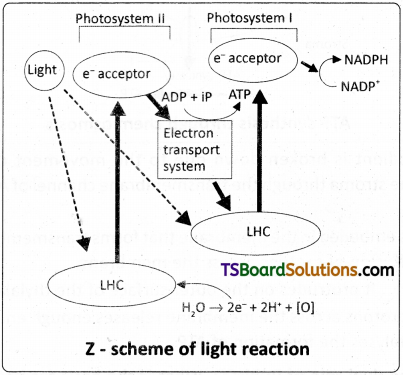
Question 6.
Explain various aspects of Mitchell chemiosmotic hypothesis, with the help of diagrams.
Answer:
Mitchell proposed chemiosmotic hypothesis to explain ATP synthesis.
ATP synthesis is linked to development of proton gradient across the membrane.
a) Since splitting of the water molecule takes place on the inner side of the membrane, the protons or hydrogen ions that are produced by the splitting of water accumulate within the lumen of the thylakoids.
b) As electrons move through the transport chain, protons are transported across the membrane. This happens because the primary acceptor of electrons which are located towards the outer side of the membrane transfers its electron not to electron carrier, but to (H+) proton carrier (PQ). Hence it removes protons, from the stroma which transporting an electron. When this molecule passes its electron, to the electron carrier on the inner side of the membrane, the proton is released into the inner side or lumen of the membrane. Then proton gradient across the membrane increases due to quinones.
c) The NADP reductase enzyme is located on the stroma side of the membrane. Along with the electrons that come from the acceptor of electrons of PS I, protons are necessary for the reduction of NADP+ to N ADPH + H+. These protons are also removed from the stroma. Thus protons in the stroma decrease in number. Where as in lumen protons are accumulated. This creates a proton gradient across the thylakoid membrane and the pH in the lumen decreases.
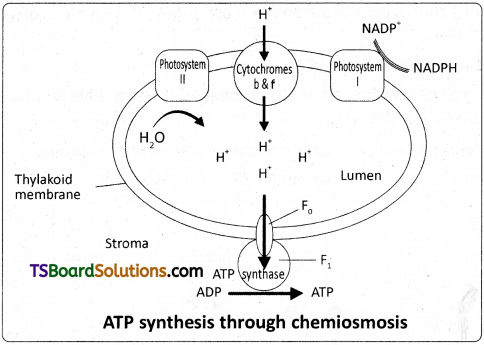
The proton gradient is broken down due to the movement of protons across the membrane to the stroma through the transmembrane channel of ATPase. ATPase consists of two parts.
- One is F0. F0 is embeded in the membrane that forms transmembrane channel it carries facilitated diffusion of protons across the membrane.
- Other one is F1 It protrudes on the outer surface of the thylakoid membrane.
Diffusion of protons across the membrane releases enough energy to activate ATPase enzyme that catalyses the formation of ATP.
![]()
Question 7.
Comment on the dual role of RuBisCO. What is the basis for its oxygenation activity? Why is this activity absent or negligible in C4 plants?
Answer:
RuBisCO is the most abundant enzyme in the world. It is characterised by the fact that its active site can bind to both CO2 and O2. Thus it shows dual role. It is written a Ribulose bisphosphate carboxylase – oxygenase. Generally, RuBisCo has greater affinity for CO2 than O2. This binding is competitive. It is the relative concentration of O2 and CO2 that determines which of the two will bind to the enzyme.
In C3 plants some O2 does bind to RuBisCO and hence CO2 fixation is reduced. Here RuBP instead of forming 2 molecules of PGA forms one molecule of phosphoglycerate and phosphoglycelate. This pathway is called photorespiration. In this photorespiration sugar or ATP or NADP are not formed. Moreover, CO2 is released with the utilisation of ATP molecule. Hence it is wasteful process.
In C4 plants photorespiration is negligible or absent because mechanism that increases the concentration of CO2 at the enzyme site. C4 acid from the mesophyll is broken down in the bundle sheath cells to release CO2. This results in increasing the intracellular concentration of CO2. This makes RuBisCO function as carboxylase, minimising oxygenase activity.
Intext Question Answers
Question 1.
By looking at a plant externally, can you tell whether a plant is C3 or C4? Why and how?
Answer:
In C3 plants photorespiration occurs. In C3 plants transpiration is more. They occur in all types climates. They have much lower temperature optimum. C3 plants respond to increased CO2 concentration. C4 plants are found in dry tropical and subtropical regions. E.g. : Sugarcane, maize, sorghum, amaranthus etc. They tolerate higher temperatures. They show a response to high light intensities. They lack photorespiration. They have greater productivity of biomass. They transpire less.
Question 2.
By looking at which internal structure of a plant can you tell whether a plant is C3 or C4? Explain.
Answer:
By looking at the vertical section of leaf we can tell whether a plant is C3 or C4. The C4 plant leaves have Kranz anatomy. Large cells around the vascular bundle called bundle sheath cells are present. The bundle sheath cells have a large number of chloroplasts, thick walls impervious to gaseous exchange and no intercellular spaces.
E.g.: Maize, sorghum etc.
In C3 plants, chloroplast dimorphism is not present, cells participating will have only one type of chloroplast. In C4 plants, chloroplast dimorphism is present. Cells participating will have two types of chloroplasts (agranal and granal).
Question 3.
Even though a very few cells in a C4 plant carry out the biosynthetic – Calvin pathway, yet they are highly productive. Can you discuss why?
Answer:
RuBisCO has an active site which can bind to both CO2 and O2. RuBisCO has greater affinity for CO2 than for O2. It is the relative concentration of 02 and C02 that determine which of the two will bind to the enzyme. In C4 cycle, RuBisCO is present in bundle sheath cells, C02 concentration is more in bundle sheath cells. Hence productivity is high. In C3 cycle some O2 does bind to RuBisCO, leading to photorespiration. So CO2 fixation is decreased.
Question 4.
RuBisCO is an enzyme that acts both as a carboxylase and oxygenase. Why do you think RuBisCO carries out more carboxylation in C4 plants?
Answer:
RuBisCO is an enzyme that acts both as a carboxylase and oxygenase. In C4 plants RuBisCO is present only in bundle sheath cells. So oxygenation of RuBisCO is avoided. These plants have CO2 concentrating mechanism. That is why RuBisCO carries more carboxylation in C4 plants.
Question 5.
Suppose there were plants that had a high concentration of chlorophyll b, but lacked chlorophyll a, would it carry out photosynthesis? Then why do plants have chlorophyll b and other accessory pigments?
Answer:
Plants having high concentration of chlorophyll b, but lacked chlorophyll a would not carry photosynthesis. Chlorophyll a shows maximum absorption in the blue and red regions where maximum photosynthesis occurs. Hence chlorophyll a is the chief pigment of photosynthesis. Plants have chlorophyll b and other accessory pigments to absorb light and transfer the energy to chlorophyll a and protect chlorophyll a from photo oxidation.
![]()
Question 6.
Why is the colour of a leaf kept in the dark frequently yellow, or pale green? Which pigment do you think is more stable?
Answer:
Colour of the leaf is not due to single pigment but due to four pigments. We can separate these pigments by chromatographic separation.
- Chlorophyll a – bright or blue green
- Chlorophyll b – yellow green
- Xanthophylls – yellow
- Carotenoids – yellow to yellow orange
Chlorophyll a is the most stable pigment.
Question 7.
Look at leaves of the same plant on the shady side and compare it with the leaves on the sunny side. Or, compare the potted plants kept in the sunlight with those in the shade. Which of them has leaves that are darker green? Why?
Answer:
The leaves of the plant potted in the sunlight will be more green as compared to the leaves of the plant potted in the shade. This is because the amount of chlorophyll in a leaf has a direct relationship with the rate of photosynthesis. In dark, the photosynthesis decreases. So it appears pale.
Question 8.
Figure shows the effect of light on the rate of photosynthesis. Based on the graph, answer the following questions :
a) At which point/s (A, B or C) in the curve is light a limiting factor?
b) What could be the limiting factor/s in region A?
c) What do C and D represent on the curve?
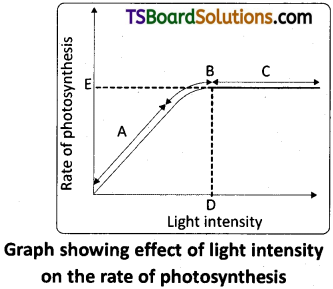
Answer:
a) At higher light intensities the rate of photosynthesis become limiting factor – A/B.
b) Light
c) Saturation of light (C).
The rate of photosynthesis is not increased by increasing intensity of light (D).
Question 9.
Give comparison between the following :
a) C3 and C4 pathways.
b) Cyclic and non-cyclic photophosphorylation,
c) Anatomy of leaf in C3 and C4 paints.
Answer:
a)
| C3 pathway | C4 pathway |
| 1. C3 pathway is in C3 plants. Which are mostly temperature. Some are tropical. | 1. C4 pathway is found in C4 plants which are mostly found subtropical and tropical region. |
| 2. Leaves do not show Kranz anatomy. | 2. Leaves show Kranz anatomy. |
| 3. Chloroplasts are similar and do not exhibit dimorphism. | 3. Chloroplast exhibit dimorphism. They are agranular and granular chloroplast. |
| 4. CO2 is fixed and reduced through Calvin cycle. | 4. CO2 is fixed through C4 pathway. |
| 5. In C3 plants, RuBP is the primary acceptor of CO2. | 5. In C4 plants, PEP is the primary acceptor of CO2. |
| 6. In C3 plants, the first stable product is phosphoglyceric acid. | 6. In C4 plants, the first stable product is oxaloacetic acid. |
| 7. C3 plants are less efficient in utilising CO2. | 7. C4 plants are more’efficient in utilising CO2. |
| 8. Photorespiration is very high. | 8. Photorespiration is not detectable. |
| 9. The optimum temperature for C3 pathway is 15 – 25°C. | 9. The optimum temperature for C4 pathway is 30 – 45°C. |
| 10. Photosynthetic yield is low to average. | 10. Photosynthetic yield is very high. |
| 11. C3 plants utilise 18 ATP molecules for synthesis of one glucose molecule. | 11. C4 plants utilise 30 ATP molecules for the synthesis of one glucose molecule. |
| 12. CO2 compensation is very high. | 12. CO2 compensation point is low. |
| 13. C3 plants utilise water less efficiency. | 13. C4 plants utilise water more efficiency. |
b)
| Cyclic photophosphorylation | Non-cyclic photophosphorylation |
| 1. Only one photosystem (PS 1) is involved. | 1. Two photosystems (PS 1 & PS II) operates simultaneously in series. |
| 2. Utilises only longer wavelength of light. | 2. Uses both longer and shorter wavelengths of light. |
| 3. Electrons move in a closed circle. | 3. Electrons move in a zig-zag manner. (Z – scheme) |
| 4. Photolysis of water does not occur, hence O2 is not evolved. | 4. Water is oxidised, thus oxygen is evolved. |
| 5. Process is not inhibited by DCMU. | 5. Process is inhibited by DCMU. |
| 6. Only one ATP is formed without NADPH. | 6. Two ATP molecules are formed along with one NADPH. |
c)
| Anatomy of C3 leaf | Anatomy of C4 leaf |
| 1. Kranz anatomy is not shown. | 1. Leaves show Kranz anatomy. |
| 2. Chloroplast does not show dimorphism. | 2. Chloroplast shows dimorphism. |
![]()
Question 10.
Cyanobacteria and some other photosynthetic bacteria do not have chioroplasts. How do they conduct photosynthesis?
Answer:
Due to presence of chlorophyll pigments bacteria xanthophyll, phycobillins. They conduct photosynthesis in cyanobacteria. In xanthophyll, photosynthetic bacteria have bacterial chlorophyll, chlorobial chlorophyll conducts photosynthesis.
Question 11.
Does moonlight support photosynthesis?
Answer:
Yes, at very low rate.
Question 12.
Why does photorespiration not occur in C4 plants?
Answer:
In C4 plants RuBisCO is present only in bundle sheath cells. So oxygenation of RuBisCO is avoided. So photorespiration does not occur.
Question 13.
Tomatoes, chillis and carrots are red in colour due to the presence of one pigment. Name the pigment. Is it a photosynthetic pigment?
Answer:
- Carotenoids.
- It absorbs light of different wavelength and also protect of photo-oxidation.
Question 14.
If a green plant is kept in dark with proper ventilation, can this plant carry out photosynthesis? Can anything be given as supplement to maintain its growth or survival?
Answer:
No, it cannot carry photosynthesis.
Yes, artificial light.
Question 15.
Photosynthetic organisms occur at different depths in the ocean. Do they receive qualitatively and quantitatively the same light? How do they adapt to carry out photosynthesis under these conditions?
Answer:
No, they don’t receive same light.
Diffuse light.
Question 16.
In tropical rain forests, the canopy is thick and shorter plants growing below it, receive filtered light. How are they able to carry out photosynthesis?
Answer:
They get modified into epiphytes.
Question 17.
Why do you believe chloroplast and mitochondria to be semi-autonomous organelle.
Answer:
Due to the presence of circular double stranded DNA.
![]()
Question 18.
Is it correct to say that photosynthesis occurs only in the leaves of a plant ? Besides leaves, what are the other parts that may be capable of carrying out photosynthesis ? Justify.
Answer:
Young plants which are green in colour Herbs.
Herbs contain green colour stem.
Photosynthetic roots. E.g.: Taeniophyllum.
Question 19.
What can we conclude from the statement that the action and absorption spectrum of photosynthesis overlap? At which wavelength do they show peaks?
Answer:
Maximum absorption by chlorophyll a and the rate of photosynthesis is highest in the blue and the red regions. It is at its peak in blue and red wavelengths.